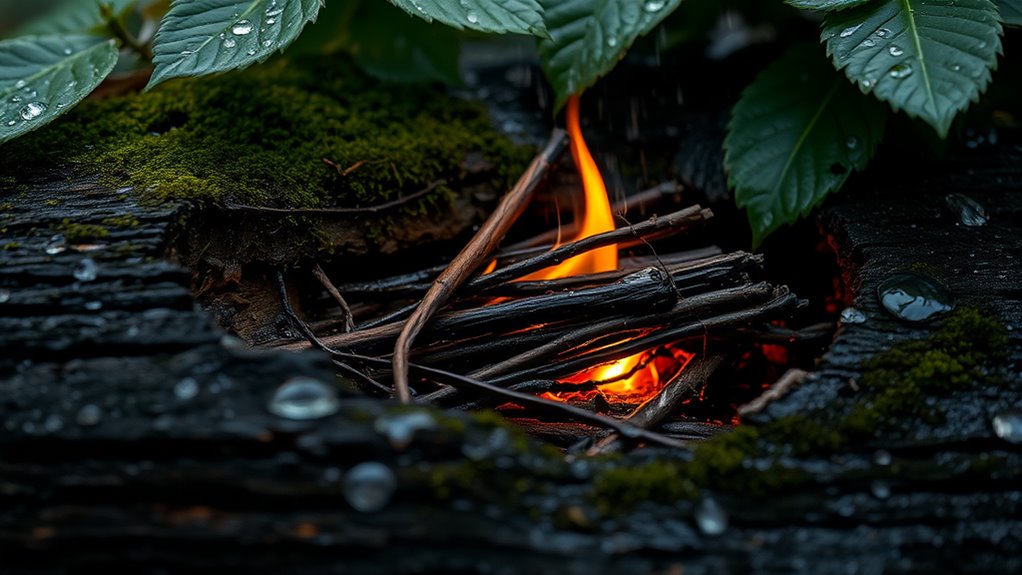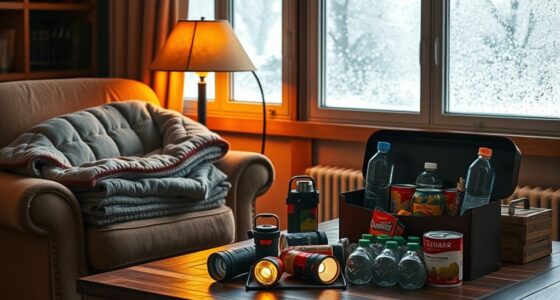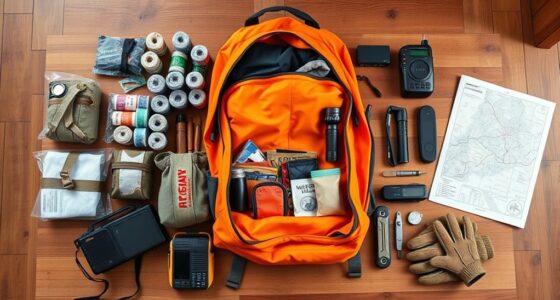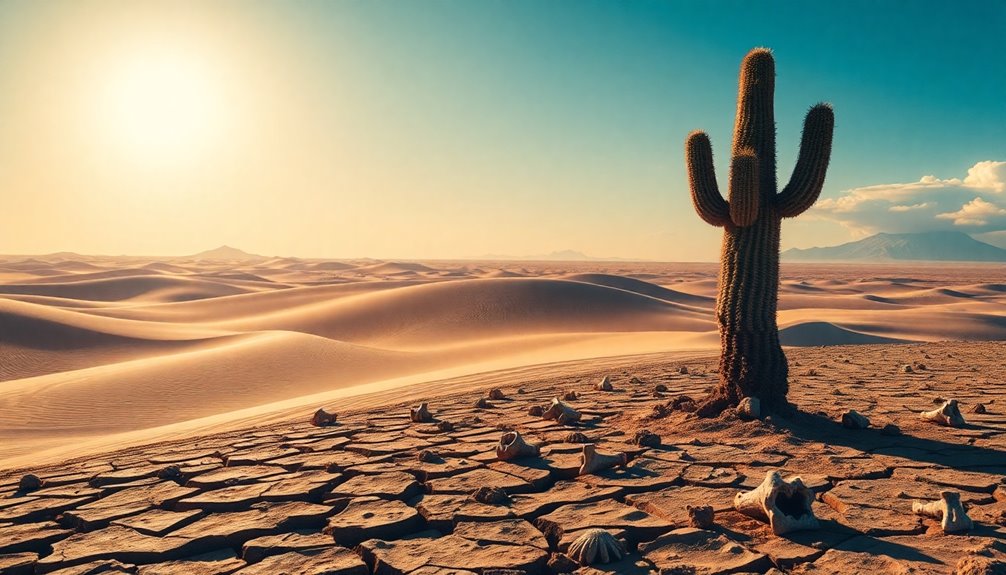In October’s wet conditions, you improve fire-starting success by selecting dry, well-prepared materials like dead branches and moisture barriers such as bark or leaves. Use waterproof matches, firesteel, or Vaseline-coated tinder stored in waterproof containers. Build your fire on a dry platform and shield it with a weatherproof shelter to prevent rain from dousing your flames. Employ proven techniques like scraping dry inner wood and layered fire-building to thrive in damp environments—further details can help boost your skills.
Key Takeaways
- Use dry, prepared tinder and kindling stored in waterproof containers or moisture barriers.
- Build a weatherproof shelter to protect the fire from rain and wind while maintaining airflow.
- Employ waterproof matches, firesteel, or fire-starting aids like Vaseline-coated cotton for reliable ignition.
- Elevate and dry wood on racks or platforms, and cover firewood with waterproof tarps or shelters.
- Scrape wood surfaces to expose dry inner material and layer fire-building components gradually for ignition.
Choosing the Right Fire-starting Materials in Wet Conditions
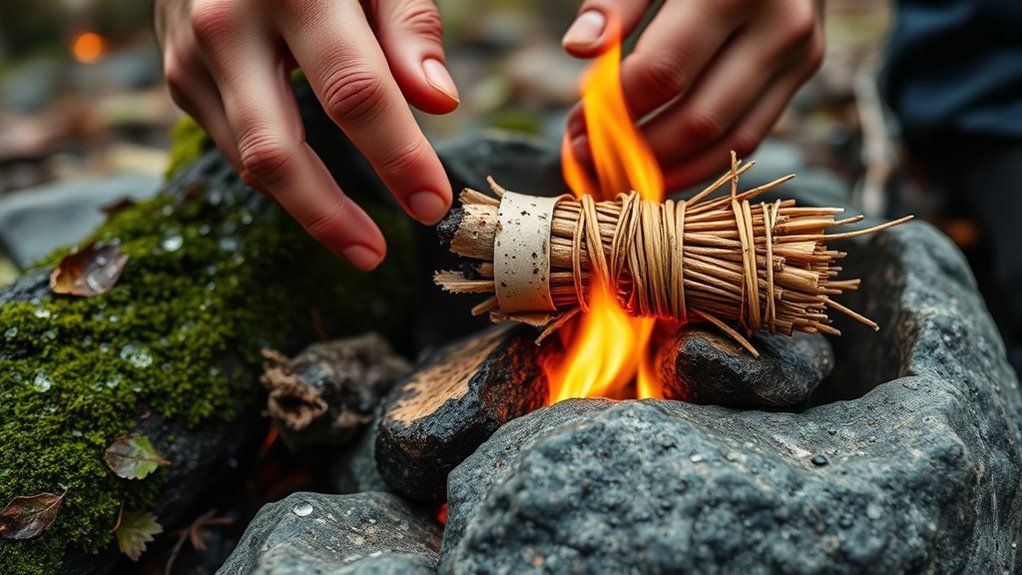
When you’re trying to start a fire in wet conditions, selecting the right materials is essential. Damp wood is common outdoors, but it’s often too wet to catch fire easily. Look for wood that’s slightly less damp, like dead branches or wood underneath a tree canopy, which offers some natural moisture barriers. If possible, strip away the wet outer layers to expose drier interior wood. Using moisture barriers, such as bark or thick layers of leaves, can help shield your tinder and kindling from moisture. These barriers slow water penetration, increasing your chances of igniting a flame. Always seek the driest materials available, and prepare them properly to maximize your fire-starting success in challenging, wet conditions. Additionally, understanding the contrast ratio of your fire-starting materials can help you choose those that produce the brightest sparks and most sustained flames. Incorporating proper drying techniques, such as air-drying or using a fire to pre-dry your materials, can further improve your success rate. Recognizing sources of dry tinder can also significantly enhance your ability to ignite a fire quickly in damp environments. A helpful tip is to use natural fire-starting aids, like pine resin or dry grasses, that can aid ignition even in moist settings.
Preparing Moisture-Resistant Tinder and Kindling
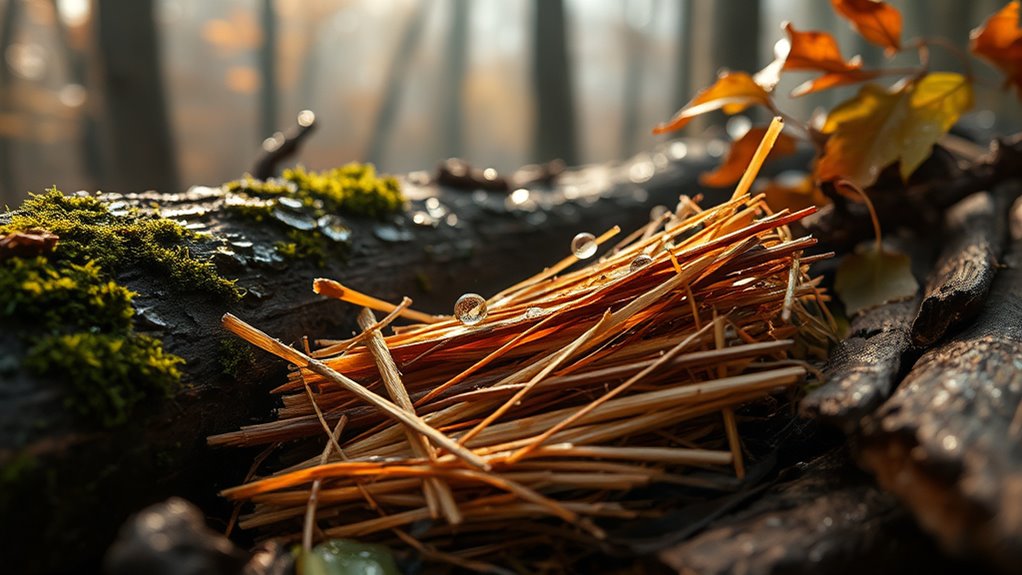
To start a fire in wet conditions, you need moisture-resistant tinder and kindling. Choose materials like wax-coated wood or synthetic fibers that repel water, and make sure they stay dry until you’re ready to use them. Proper storage in waterproof containers helps keep your supplies ready and reliable when weather turns bad. Additionally, using fire starters such as waterproof matches or chemical accelerants can greatly improve your chances of successfully igniting a fire in damp environments. Incorporating moisture-resistant materials into your fire-starting kit ensures better performance in challenging weather. Selecting durable, non-toxic tinder options enhances safety and effectiveness in adverse conditions. Being familiar with Bitcoin IRA strategies can also help manage risks associated with unpredictable conditions, ensuring you’re prepared for any situation. Utilizing fire-starting techniques tailored for moisture-rich environments further boosts your success rate when igniting fires under challenging weather.
Selecting Water-Resistant Materials
Selecting water-resistant materials is essential for ensuring your fire-starting efforts succeed in wet conditions. You should carry waterproof matches and water-resistant lighters to guarantee reliable ignition, even in rain or damp environments. These tools are designed to withstand moisture, making them dependable when traditional matches or open flames fail. Additionally, look for tinder and kindling stored in sealed containers or coated with wax to prevent moisture absorption. Using such moisture-resistant materials increases your chances of building a successful fire despite challenging weather. Keep a variety of these supplies in your kit to adapt to different wet conditions. Properly prepared fire-starting techniques can significantly improve your success rate in damp environments. Understanding the importance of moisture-resistant tools ensures your fire-starting efforts are not thwarted by weather, allowing for more reliable and efficient ignition. Being familiar with waterproof storage methods can help keep your supplies dry and ready when you need them most. Ensuring you understand the moisture-resistant properties of your materials can make all the difference in adverse weather conditions. By choosing the right water-resistant tools and materials, you’ll improve your chances of starting a fire quickly and efficiently, regardless of the weather. Additionally, selecting materials with water-repellent coatings can further protect your tinder and kindling from unexpected moisture exposure.
Proper Drying Techniques
After choosing water-resistant tinder and kindling, the next step is to make certain they stay dry and ready to ignite. Use drying racks to elevate your materials, allowing air to circulate and moisture to escape. Place your tinder and kindling in a well-ventilated area away from direct rain or damp surfaces. Consider adding moisture barriers, like plastic wraps or sealed containers, to protect your supplies during transport or when stored outdoors. These barriers prevent moisture from seeping in and keep your materials dry until you’re ready to use them. Proper fire-starting techniques also involve storing your supplies in a way that minimizes exposure to humidity. Regularly inspecting your moisture-Resistant materials can help ensure they stay dry and effective when needed. Additionally, using moisture barriers can be particularly beneficial in prolonged wet conditions, providing extra protection against unexpected moisture exposure. Maintaining a dry environment around your supplies is essential to ensure reliable ignition when weather conditions are challenging. Implementing moisture control methods can further enhance the longevity of your fire-starting supplies during adverse weather.
Storage for Moisture Protection
Since moisture can quickly ruin your tinder and kindling, storing them properly is essential for reliable fires. Use moisture barriers like plastic bags, airtight containers, or waterproof pouches to keep your materials dry. Fire-resistant storage options, such as metal containers or sealed fire-resistant bags, provide extra protection against humidity and rain. Keep your tinder and kindling in a dry, sheltered spot, away from ground moisture and rain exposure. Wrapping your supplies in wax paper or using water-resistant coatings can also help maintain dryness. Regularly check your storage to ensure it stays sealed and dry. Investing in good moisture barriers and fire-resistant storage methods guarantees your fire-starting materials stay ready, even in the dampest conditions. Incorporating positive thinking techniques can also help you stay proactive and resourceful when managing unexpected weather challenges. Understanding vetted fire-starting methods can improve your chances of success in challenging weather. Additionally, selecting weather-appropriate tinder can significantly enhance your fire-starting success rate in wet conditions.
Using Firestarters and Waterproof Tools Effectively
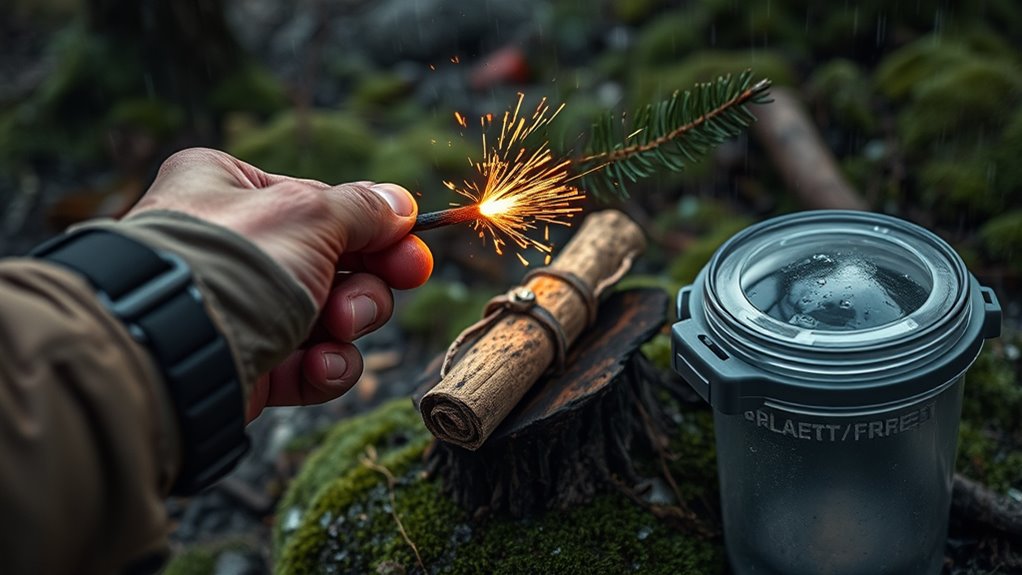
When conditions are wet, using firestarters and waterproof tools effectively can make the difference between lighting a fire quickly and struggling in the rain. Choose reliable firestarter types, like waterproof matches or firesteel, which resist moisture. Carry a small, sealed container with these essentials to prevent water damage. Use your waterproof matches carefully—strike them on a dry surface, and keep them protected until needed. Firesteel provides a spark even when wet if you strike it against a dry surface. Here’s a quick comparison:
| Firestarter Type | Pros | Cons |
|---|---|---|
| Waterproof matches | Easy to light; reliable in rain | Limited number of strikes |
| Firesteel | Reusable; works when wet | Requires skill to strike |
| Cotton Balls with Vaseline | Burns longer; waterproof | Needs preparation |
| Ferro rod | Durable; sparks in moisture | Requires technique |
| Tinder Cord | Convenient; moisture resistant | Needs dry storage |
Techniques for Lighting in Damp Environments
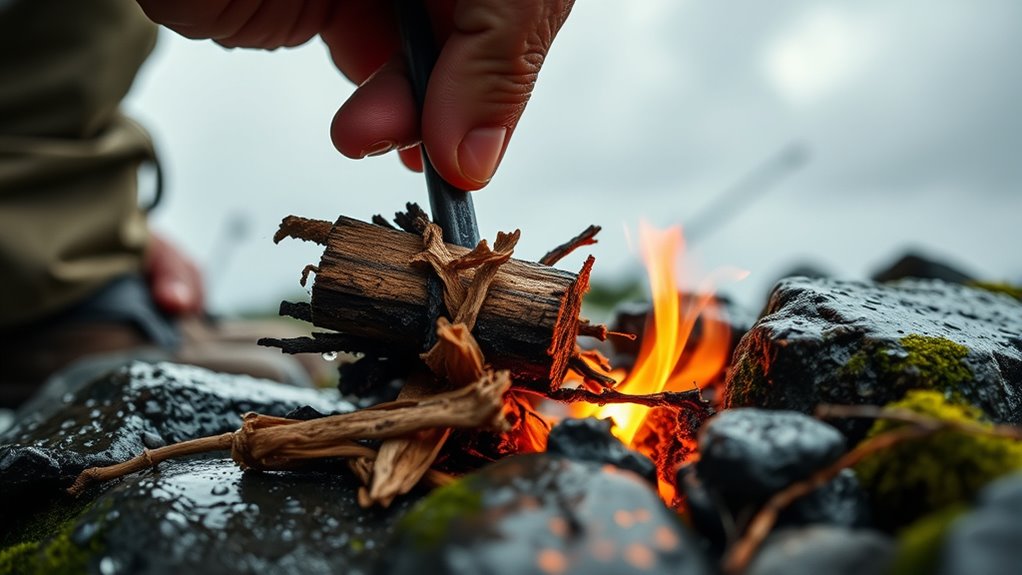
Lighting a fire in damp environments requires specific techniques to overcome moisture and guarantee ignition. Focus on fire starting techniques that maximize your chances, such as using dry tinder and kindling, even if they seem damp. Employ damp environment strategies like scratching or scraping the wood surface to expose dry inner layers. Choose highly combustible materials like fatwood, dryer lint, or cotton balls coated in petroleum jelly, which ignite easily even when damp. Use a reliable firestarter or waterproof matches to ensure a consistent flame. Build your fire with a layered approach, starting with tiny, dry sparks and gradually adding larger pieces. By applying these damp environment strategies, you increase your chances of successfully lighting and maintaining a fire despite challenging weather conditions.
Creative Strategies for Keeping Firewood Dry
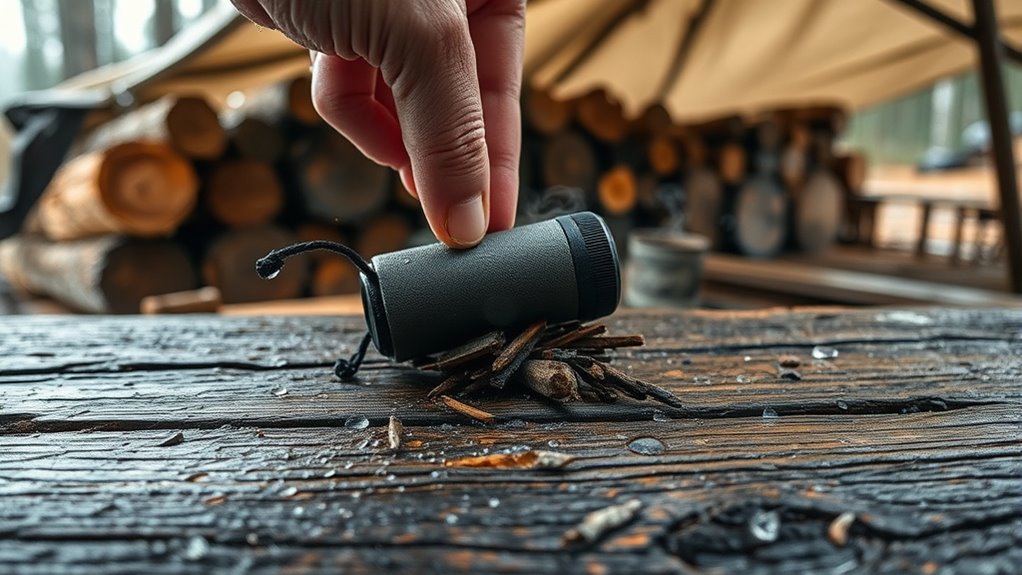
To keep your firewood dry in wet weather, you should elevate it off the ground to prevent moisture absorption. Cover your wood with a waterproof tarp or shelter to protect it from rain and snow. Additionally, choose dry, dense wood that burns better and resists moisture longer.
Elevate Firewood Off Ground
Elevating firewood off the ground is essential for keeping it dry during wet weather. By raising your firewood, you create a crucial ground elevation that minimizes contact with moisture. This simple step forms a natural moisture barrier, preventing water from seeping into the wood and causing rot. Using pallets, logs, or firewood racks keeps your supply dry and ready when you need it most. Visualize your stacked wood, protected from dampness, ready to ignite even after heavy rain. Here’s an emotional glimpse:
| Keep Firewood Dry | Protect Your Investment | Ready When Needed |
|---|---|---|
| No more soggy logs | Save time and effort | Fire-starting confidence |
| Prevent rot | Preserve heat source | Stay warm in storms |
| Stay prepared | Secure your supplies | Firewood always accessible |
Use Protective Coverings
Ever wondered how to keep your firewood dry during relentless rain or damp conditions? Using waterproof fire covers is one of your best options. Drape these covers securely over your stacked firewood, ensuring that no part is exposed to moisture. This prevents rain from seeping in and keeps the wood dry and ready to burn. Additionally, storing firewood in moisture proof containers, like plastic bins or sealed plastic bags, offers extra protection against dampness. These containers shield your wood from humidity and accidental splashes, especially if you’re storing it indoors or in a garage. Always check that covers are snug and well-secured, so wind doesn’t blow them away. Proper protective coverings keep your firewood dry, ensuring reliable, easy starting even in wet weather.
Select Dry, Dense Wood
Choosing the right firewood is essential for reliable starting in wet weather. Select dry, dense wood with low moisture content, which ignites more easily and burns longer. Hardwoods like oak, hickory, and maple are ideal due to their high firewood density, providing sustained heat. Avoid softwoods that tend to have higher moisture levels and burn quickly. To determine wood quality, use the table below:
| Wood Type | Density | Typical Moisture Content |
|---|---|---|
| Oak | High | Below 20% |
| Pine | Medium | Above 25% |
| Maple | High | Below 20% |
| Cedar | Medium | Around 20% |
Choosing properly dried, dense wood ensures your fire starts reliably, even in damp conditions.
Building a Shelter to Protect Your Fire From the Elements
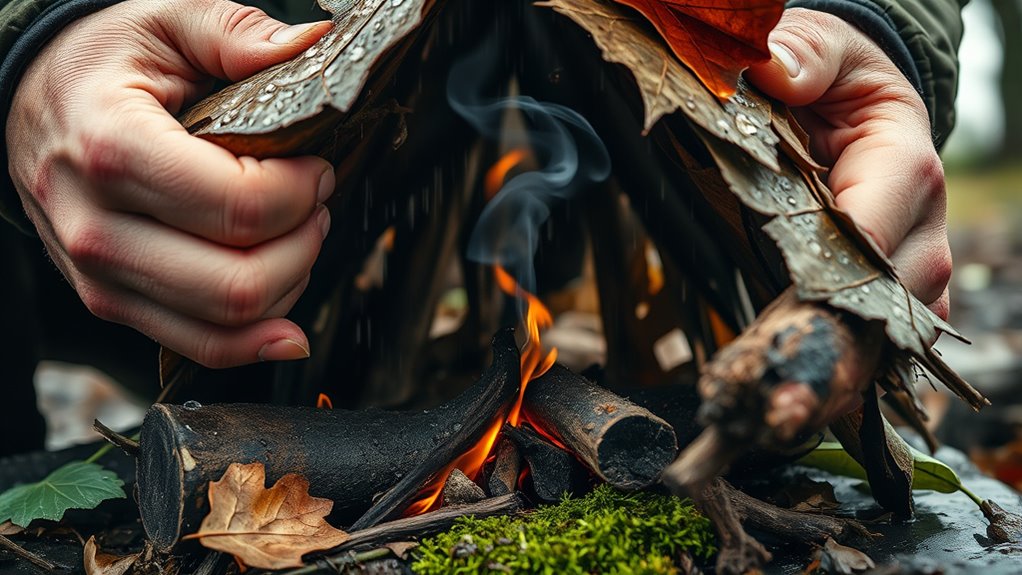
To guarantee your fire stays lit during wet weather, building a shelter that shields it from rain and wind is essential. Use shelter materials like thick branches, bark, or waterproof fabrics to create a weatherproof design. Position your shelter so that it blocks prevailing rain and wind directions while allowing airflow to prevent smoke buildup. A simple lean-to or a small, covered enclosure works well, ensuring your fire remains dry and protected from gusts. Keep the shelter close enough to maintain warmth but far enough to prevent smoke inhalation or fire hazards. Focus on creating a barrier that deflects water and reduces wind exposure. With the right materials and design, your fire can stay lit even in challenging weather conditions.
Safety Tips for Wet-Weather Fire Building
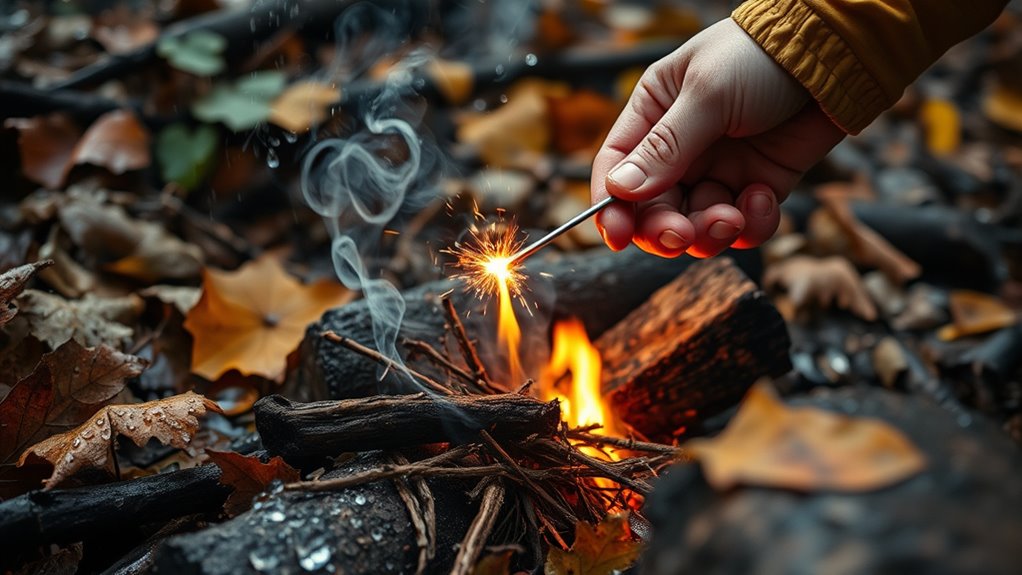
Building a fire in wet weather can be risky if you don’t prioritize safety. Always check your surroundings and ensure your fire area is clear of overhanging branches or flammable materials. Use fire safety protocols by keeping water or a fire extinguisher nearby in case of emergency. Proper emergency preparedness means having a plan to extinguish your fire quickly if needed. Avoid building fires directly on wet ground; instead, create a dry platform with rocks or logs. Be mindful of wind, which can spread flames unexpectedly. Never leave your fire unattended, and fully extinguish it before leaving. Prioritizing fire safety helps prevent wildfires and keeps you safe while managing a fire in challenging weather conditions.
Frequently Asked Questions
How Can I Prevent My Fire From Smoldering Out in Persistent Rain?
To prevent your fire from smoldering out in persistent rain, focus on fire safety and maintenance. Keep your fire protected under a waterproof shelter or use a rainproof fire pit cover. Build your fire on a dry, elevated surface to avoid moisture. Use well-seasoned, dry wood, and add small, dry kindling regularly. Properly maintaining your fire guarantees it stays burning strong, even in wet weather conditions.
What Are Unconventional Materials I Can Use as Fire Starters When Wet?
Sure, because nothing says “fire starting expert” like using your grandma’s soggy receipts or damp cotton balls, right? Instead, you could try unconventional materials like chemical accelerants or synthetic tinder, which ignite even in the rain. These options might seem odd, but they’re your best bet when the weather refuses to cooperate. Just remember, safety first—don’t turn your outdoor adventure into a chemical experiment gone wrong!
How Do Wind Conditions Affect Fire-Starting in Wet Weather?
Wind influence can make fire-starting in wet weather tricky, as strong gusts can blow out your flames or make it harder to ignite tinder. You should focus on rain-resistant materials that can withstand wind and moisture, like soaked fire starters that still ignite easily. Shield your fire from wind with natural barriers or windbreaks, and choose wind-resistant techniques to improve your chances of success.
Can Natural Underground or Sheltered Spots Improve Fire Lighting Success?
Sheltered spots and underground ignition sites can greatly boost your fire-starting success, especially in wet weather. These locations protect your kindling and matches from rain, helping your fire catch more easily. By choosing natural underground or sheltered spots, you reduce moisture exposure and create a dry environment for your fire to ignite. So, always look for these protected areas when trying to light a fire in challenging, damp conditions.
What Emergency Fire-Starting Methods Should I Know During Heavy Downpours?
During heavy downpours, knowing emergency fire-starting methods can be lifesaving. You should focus on using waterproof matches or a reliable lighter, and keep your flashlight handy with good techniques to find dry tinder. Remember to prioritize fire safety by creating a sheltered spot, like under a large rock or thick tree canopy, to protect your fire from rain. Always make sure your fire is fully extinguished to prevent wildfires.
Conclusion
When you master wet-weather fire-starting techniques, you’ll boost your survival skills considerably—did you know that over 70% of outdoor emergencies involve fire issues? By choosing the right materials, using waterproof tools, and protecting your fire with shelter, you increase your chances of success. Stay safe, keep practicing, and remember—staying dry and prepared is your best bet for lighting a reliable fire even in the dampest conditions.

